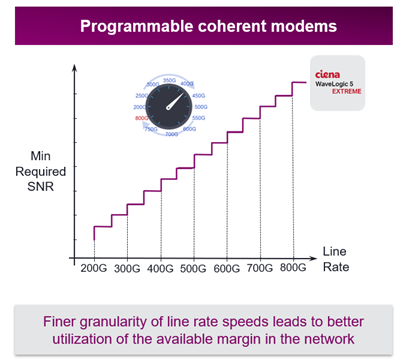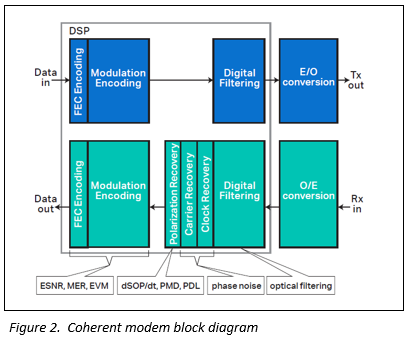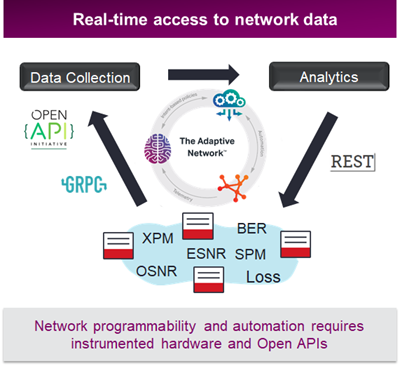Optical Network Expert Series: Designing programmable infrastructure to achieve near-zero margin networks
Part 1 in Ciena’s Optical Network Expert Series: A guide to improving future network economics with near-zero margin networking
Network providers are searching for innovative ways to drive continued transport cost reduction, given not only the market’s unrelenting demands for capacity, but also the fact that coherent technologies are approaching the theoretical limit for the amount of data that can be transmitted over a communications channel. Fortunately, providers can use advances in both software and hardware to access capacity that has been previously stranded by mining the available Signal-to-Noise (SNR) margin: enabling an optical network that can operate with near-zero margin.
Designing SNR-optimized line systemsPrevious generations of line systems were designed for fixed rate transponders, which had a corresponding fixed required SNR. At that time, the design of the line system focused on minimizing costs, as there was no benefit in exceeding the minimum required SNR of the corresponding fixed rate modem. Today, line system deployments are evolving to capacity-optimized or SNR-optimized designs using variable capacity modems that can trade off reach and capacity to optimize for the delivered SNR.
Different applications drive different criteria for line system optimization. For example, terrestrial systems today value not only improving the delivered SNR but also the photonic degree reconfigurability. One of the best features of photonics is signal independence, or—the ability to support multiple generations of transponders independent of format, bit rate, symbol rate, etc. Many networks designed for 10 and 40 Gb/s are now carrying 200 Gb/s channels, and many that were deployed with flexible grid capability are now carrying 400 Gb/s and even 800 Gb/s signals!
Technologies such as Colorless, Directionless, Contentionless (CDC) and flexible grid reconfigurable optical add/drop multiplexer (ROADM) architectures provide the highest degree of agility and flexibility so that operators can benefit from reduced OPEX, faster service turn-up and increased system optimization. In addition to total-power monitors, spectral monitoring is provided through Optical Channel Monitor (OCM) devices that act like optical spectrum analyzers. Optical Time-Domain Reflectometers (OTDRs) that characterize the transmission fiber for point losses, loss per kilometer (km), reflections, core size, etc are integrated into systems. In the past, without this instrumentation, the uncertainty around the actual parameters of deployment was built into the planning process and remained as excess margin for the life of the network. Today, this built-in line system instrumentation eliminates this uncertainty enabling operators to reclaim this margin as available SNR and therefore capacity.
Monitoring the Line SystemLine system monitoring is important when it comes to understanding the performance of the network, especially when it comes to operating at near-zero margin. Feedback from the modem is also important but it only monitors the net performance of the paths, whereas the line system can focus in on each ROADM section or individual fibers. Commonly reported metrics include EDFA gain, Raman gain, span loss, Optical Return Loss (ORL), total input and output power, per-channel power or Power Spectral Density (PSD), OSNR, etc.
An important benefit is that the incremental SNR can also be used to find “hot spots” in fiber spans or sections that are contributing the most noise to the system. This is extremely valuable insight for network providers. For example, a provider might allow routing engines to weight these links differently in path calculations or may choose to perform maintenance at these locations to improve performance and, therefore, capacity.
Designing modems for zero-margin networking Coherent modems have evolved quite a bit since their introduction. The first generation of coherent transponders deployed modems that were designed to deliver fixed capacity based on a preset Quadrature Amplitude Modulation (QAM) constellation and baud rate. Second generation designs offered the ability to choose from a selection of constellation options to adjust capacity. For example, a 35GBaud transponder could be programmed in fixed steps of 50Gb/s by selecting Quadrature Phase-Shift Keying (QPSK) for 100 Gb/s, 8-QAM for 150 Gb/s, or 16-QAM for 200 Gb/s. Today’s next-generation coherent modems are so intelligent and programmable that the modem considers a greater variety of constellation and baud options, enabling extremely granular tunability. As shown in this figure, a perfect example of this tunability is achieved with Ciena’s WaveLogic 5 Extreme modem, that can be programmed to deliver anywhere from 200Gb/s to 800Gb/s of capacity in 50Gb/s increments to maximize capacity over any distance. This precise tunability allows better use of the available margin in the network.
Coherent modems have evolved quite a bit since their introduction. The first generation of coherent transponders deployed modems that were designed to deliver fixed capacity based on a preset Quadrature Amplitude Modulation (QAM) constellation and baud rate. Second generation designs offered the ability to choose from a selection of constellation options to adjust capacity. For example, a 35GBaud transponder could be programmed in fixed steps of 50Gb/s by selecting Quadrature Phase-Shift Keying (QPSK) for 100 Gb/s, 8-QAM for 150 Gb/s, or 16-QAM for 200 Gb/s. Today’s next-generation coherent modems are so intelligent and programmable that the modem considers a greater variety of constellation and baud options, enabling extremely granular tunability. As shown in this figure, a perfect example of this tunability is achieved with Ciena’s WaveLogic 5 Extreme modem, that can be programmed to deliver anywhere from 200Gb/s to 800Gb/s of capacity in 50Gb/s increments to maximize capacity over any distance. This precise tunability allows better use of the available margin in the network.
Monitoring the modem: visibility into real-time performance metrics
Today’s advanced coherent modems have evolved to not only provide the programmability to finely tune capacity, but also provide performance metrics gathered in real-time from the network. These real-time performance metrics are extremely valuable for operators as they can be leveraged to inform the network controls that guide their operation to optimize the network.
 The key building blocks for typical DSP-based coherent modems, that mitigate channel effects and flexibly tune capacity, are illustrated in Figure 2. Channel-dependent effects are compensated for through a series of DSP processing blocks, wherein each block provides a measure of the effect for which it is compensating. Corresponding metrics, which can be extracted from each of these blocks, are listed at the bottom.
The key building blocks for typical DSP-based coherent modems, that mitigate channel effects and flexibly tune capacity, are illustrated in Figure 2. Channel-dependent effects are compensated for through a series of DSP processing blocks, wherein each block provides a measure of the effect for which it is compensating. Corresponding metrics, which can be extracted from each of these blocks, are listed at the bottom.
The Effective SNR (ESNR), perhaps the simplest of the metrics extracted from the modem, is used along with knowledge of the Required SNR (RSNR) to estimate the SNR margin as it varies over time. The benefit of margin calculated in this manner is that the calculation includes all noise sources, both linear and nonlinear, for the instance of transmitter, receiver, and channel. These real-time performance metrics are vital to driving actionable insights with the goal of network optimization. In this case, they enable the network to accurately determine the minimum SNR needed for safe operation and provide the operator with a clear indication on whether or not there is excess margin that can be used to get greater capacity from the fiber.
Predicting failures with advanced in-service monitoringIn addition to their tuning and performance monitoring functions, coherent modems provide the long-term, in-service monitoring and streaming telemetry essential to achieve near zero-margin networks. These combined capabilities can be leveraged to help the network react, anticipate, and even prevent failures.
 This real-time monitoring capability was previously not possible with traditional transport equipment, which could only recognize nominal operation or failure. Although a failure detection would trigger alarms in the network, the ability to predict failures was very limited. Performance Monitors (PMs) have existed for some time, but PMs were typically used by operators to troubleshoot an active issue or determine the root cause after the fact. In addition, traditional PMs are slow and passive, typically collecting data on network elements in 15-minute bins. Due to local storage constraints, the network could store limited history, and for just 24 hours.
This real-time monitoring capability was previously not possible with traditional transport equipment, which could only recognize nominal operation or failure. Although a failure detection would trigger alarms in the network, the ability to predict failures was very limited. Performance Monitors (PMs) have existed for some time, but PMs were typically used by operators to troubleshoot an active issue or determine the root cause after the fact. In addition, traditional PMs are slow and passive, typically collecting data on network elements in 15-minute bins. Due to local storage constraints, the network could store limited history, and for just 24 hours.
These limitations are solved today by the advanced in-service monitoring capabilities in the latest coherent modems. Streaming telemetry, used in conjunction with centralized control, storage, and analytics, can help ensure that networks operating at near-zero margin will meet service quality and reliability requirements necessary to comply with Service Level Agreements.
Modern optical network design is continuously advancing to adapt to increasing demands for capacity and automation. This trend includes a flexible photonic line system equipped with line system instrumentation designed to maximize capacity by extracting more SNR from deployed systems. Just as important are variable capacity modems with in-service monitoring and streaming telemetry, to enable the ability to precisely tune capacity to the delivered SNR, to achieve the goals of near-zero margin networking.
Check out the other installments in the blog series:
- Intro: How near-zero margin networking changes network economics
- Part 2: Leveraging network analytics for unprecedented control and monitoring by David Boertjes and David Côté
- Part 3: Applying AI to maximize capacity and Quality of Transmission by David Côté
Or want to get a more in-depth understanding of this new approach now? Download the full paper "Practical Considerations for Near-Zero Margin Network Design and Deployment" today.





